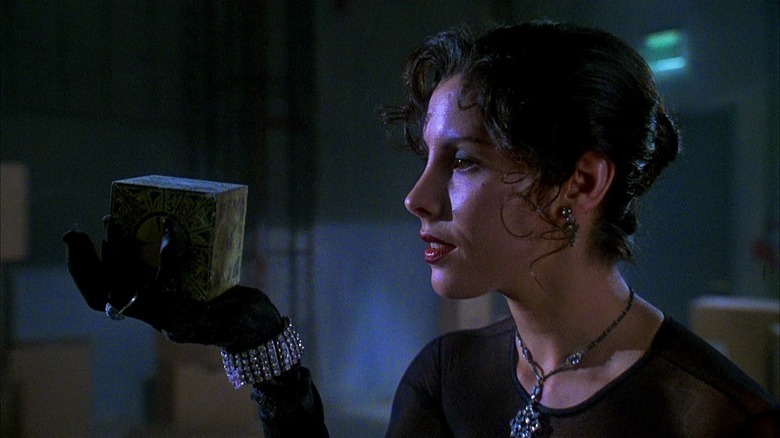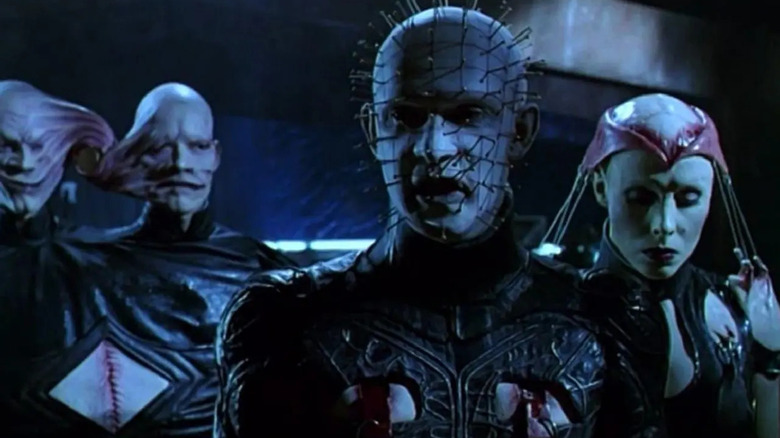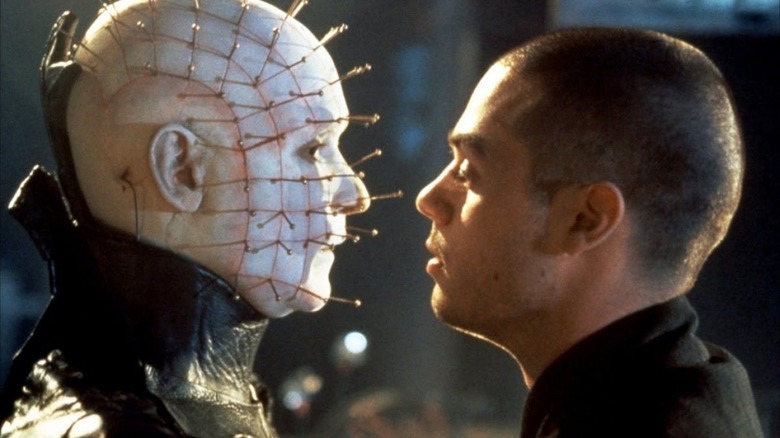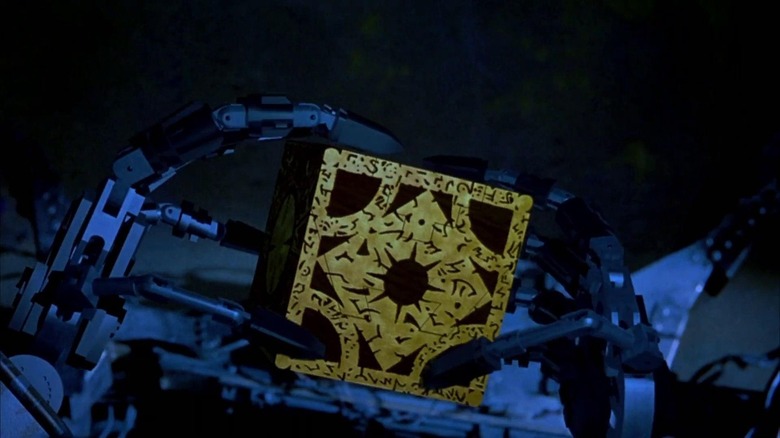The History Of The Hellraiser: Bloodline Workprint, One Of Horror's Most Mysterious Lost Treasures
On March 8, 1996, the fourth film in the "Hellraiser" film series, "Hellraiser: Bloodline," was released in theaters. It purported to be the final film in the series, as it would feature the death of Pinhead (Doug Bradley), the demonic sadomasochist summoned from the rough sex dimension via an elaborate magical puzzle box.
"Bloodline" took an impressively ambitious narrative tack, taking place over three time periods, several centuries removed from one another. It began in 1796 with the original maker of the puzzle box, then fast-forwarded to the present and caught up with Pinhead and a descendent of the puzzle-maker. Its third act took place in 2127 on board a space station where Pinhead would be summoned to torture astronauts.
At the time, "Hellraiser: Bloodline" was largely dismissed by audiences. It didn't get good reviews, and many looked askance at the idea of Pinhead in space. It came at a time when several horror franchises were sending their monsters into space in what appeared to be sheer creative desperation ("Leprechaun 4: In Space," "Jason X," et al). Despite its reputation, "Bloodline" holds together surprisingly well. The performances are solid (it features a young Adam Scott as a foppish French hedonist), and the multi-century story is novel and well-told. This, despite a notoriously troubled production and infamously extensive reshoots.
The "Bloodline" production troubles were well-known in 1996. Director Kevin Yagher had to remove his name from the credits after Miramax recut and reshot multiple scenes without his input, leaving him incensed. "Bloodline" is credited to Alan Smithee, the pseudonym used for filmmakers asserting anonymity. Rumor had it that Yagher's original cut was larger, better-paced, and not as schlocky.
The geniuses at Arrow Video have unearthed Yagher's original cut in the form of a long-lost workprint.
Let's examine the differences.
First, some background
One can get a taste of what Yagher's cut of "Bloodline" might have looked like from the published screenplay, written by Peter Atkins. The original screenplay took place in chronological order, beginning in 1796. The theatrical cut began in the future and was told largely in flashback. The mythology of the "Hellraiser" series dictated that Pinhead was originally a World War I solder named Elliott Spenser who was transformed into a vicious sadomasochist by the magical powers of a Hell-like dimension of hedonism. Indeed, the kind of leather wear and torture equipment that Pinhead employed were all modern inventions, making the S&M-heavy Cenobites the product of a very particular time and place in the rough sex scene. Pinhead, then, could not appear in the 1796 sequences, and wouldn't appear in "Bloodline" until about halfway through its running time.
According to Paul Kane's 2013 book "The Hellraiser Films and Their Legacy," Miramax was skittish about making a "Hellraiser" movie wherein Pinhead didn't appear right away, so they reordered the chronological time frame and shaved down a lot of the incident in order to get to Pinhead faster (the theatrical cut is only 85 minutes). Stuart Gordon was initially set to direct but left over creative differences. Yagher reluctantly took the job when Clive Barker — the famed writer/director of the original "Hellraiser" and executive producer on "Bloodline" — spoke highly of Atkin's screenplay. He shot Atkin's screenplay in its entirety.
It was late in the game that Miramax changed their minds about the structure of the film. They ordered a rewrite, and hired Joe Chapelle to direct several all-new scenes (Bradley confirmed that it was far more than mere "reshoots.") Yagher stepped away and washed his hands of the experience.
The original cut
The shoot was terrible and, in Kane's book, Doug Bradley is quoted as calling it the "shoot from Hell" without a hint of irony. Major crew members were replaced partway through shooting, including the first cinematographer, and a lot of people got sick on set (not because of the blood; it was a run-of-the-mill illness). Yagher, however, gutted it out and turned in a cut that was 110 minutes long.
The original cut, as seen in Atkins' screenplay, saw a conflict between the modern Pinhead and an old-world demon named Angelique (Valentina Vargas) who preferred a more traditional "temptation" technique to claim souls. Pinhead, meanwhile, merely offered willing takers the ultimate sensual experience. The two demons hated each other, and there was a scene where Pinhead and Angelique had a bloody and violent battle.
Some VHS footage of Yagher's original complete workprint has leaked to the public and enterprising fans have assembled their own cuts and published them on YouTube.
On October 23, however, Arrow Video will release a box set called the Quartet of Tormet and it will feature the first four "Hellraiser" movies on Blu-ray, or 4K UHD. It will also include the very first officially sanctioned release of the "Bloodline" workprint. According to Bloody Disgusting, the new workprint is the official Yagher cut and differs from any of the versions that have been floating around online unauthorized. The statement given to Bloody Disgusting was as follows:
"The workprint version of 'Hellraiser: Bloodline' features temporary music and sound effects, and was assembled sometime after Kevin Yagher's departure from the film. This version, which has a different plot structure and some alternate material compared to the final 'Alan Smithee' cut, is presented from a timecoded VHS, the best material available."
This is a coup.
An incomplete Bloodline
Atkins pointed out that a complete version of his screenplay still doesn't exist. In a 2021 interview with Bloody Disgusting, the screenwriter pointed out that Yagher only shot about 90% of the movie he wanted and, even then, it hardly included everything in the original screenplay. Those hoping for a larger, Snyder-cut-esque version of "Bloodline" may be disappointed by the new Arrow Video release. The workprint is just that: a workprint. It's not a "director's cut" in the traditional sense.
It will be, however, as complete a version of "Bloodline" as we will ever see, and that's not nothing.
As stated above, the theatrical cut is actually a perfectly watchable movie. Despite all its troubles, "Bloodline" is still a sight better than "Hellraiser III: Hell on Earth," which altered the nightmarish qualities of the first two "Hellraiser" movies into a pat, silly American slasher movie.
Clive Barker's original "Hellraiser" remains a classic, hefty with mythology and mature themes of lust and sexuality. The Cenobites are not bloodthirsty monsters, but austere sexual doms eager to tear apart eager, consenting subs. In Tony Randel's surreal "Hellbound: Hellraiser II," easily one of the best horror films of the 1980s, Barker's sexual themes were expanded into psychological obsession. "Hell on Earth" dropped all the hefty thinking and replaced it with dumb kills and Cenobites made of compact discs and cocktail shakers. It turned the series into a rote slasher. One can admire that "Bloodline" stepped in to clean up the mess and justify some of Pinhead's out-of-character behavior from part III.
"Bloodline" is, by personal estimation, the third-best "Hellraiser" movie, and audiences will finally have the chance to see its complete (ish) version for the first time. A little bloody treasure has been exhumed.



